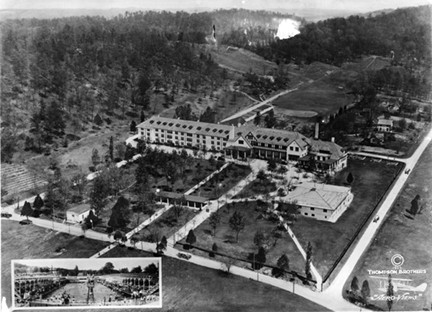Its motto did not really apply until the major construction of 1917-18, but eventually the Whittle Springs Hotel and Resort lived up to the motto “The Playground of the Southland.”
The 26-acre plat dated back to the 1790 North Carolina land grant of the McCampbells. James Madison Whittle (1850-1944) and Sophronia Hodges Whittle (1848-1924) purchased it from the Rev. J.N. Durham in 1886. Whittle, a former Sevier County merchant, built the first “hotel” on the property in 1890. It might have been called a “boarding house” at the time as it consisted of only 10 rooms; but in several phases, it was eventually expanded to 46 rooms.
The Fountain Head Railway (1890-1905) made one of its 23 stops at Whittle Springs, so convenient transportation was available from the downtown terminus at Central Market (Emory Park). At 35 miles an hour, the trip required only 30 minutes one way. In addition, the open-air cars made spring, summer and fall trips fun. When the “Dummy Line” sold in 1905, it was replaced by electrified trolleys and later by streetcars using the same standard gauge tracks.
Whittle Springs Hotel had something the Fountain Head Hotel did not offer — its therapeutic spring waters. By one account, James Whittle discovered the springs while excavating for his first building. Another says that there was a spring on the property and that he “dowsed” and discovered three additional sites for wells within a few hundred feet of it. The Epsom-Lithia, Chalybeate, Magnesium Chalybeate and Free Stone waters were of such quality that they won the highest award at the St. Louis Exposition in 1904.
The hotel attracted many families from East Tennessee and from many eastern states. Its popularity grew geometrically after it was replaced with a Barber and McMurry designed 125-room hotel and resort built in 1917-1918 at a cost of $650,000 (the equivalent of more than $ 10 million today).
The board of directors was impressive: J.W. Williams, president of the Lick Branch Coal Company of Harlan, Ky., who had just purchased the Woodward-Williams Mansion (Park Place) on Broadway, was president. His brother, Dover Williams, who also had extensive coal mining operations in Kentucky and had just purchased and rebuilt the Woodward-Morgan-Williams Mansion (Lakeview, now Gentry-Griffey Chapel), was one of the vice-presidents. Two of James M. Whittle’s sons were also officers: Orville F. Whittle as another vice-president and Robert H. Whittle as the secretary and treasurer.
J.J. Farrell was hired as head chef to provide excellent cuisine for the elegant dining room. Farrell had many years’ experience with hotels in the Adirondacks, Thomas Healy’s Golden Glades restaurant in New York City and in Atlantic City hotels.
Labor Day 1918 was a festive occasion as the grand opening of the new facility attracted hundreds to view the whitewashed brick hotel designed to resemble an Old English inn. The massive columns, numerous gables and dormers and English windows with small panes made the architecture unique for East Tennessee. The spacious main lobby had a large fireplace in one end with a mixed tile and marble floor and black wrought iron electric fixtures overhead. Its elegant French draperies and upholstered wicker furniture informed incoming guests that they had arrived in a special place.
An old-English oak stairway at the rear of the lobby led to the mezzanine floor which housed the corporate offices and the board room. The musicians’ gallery at one end overlooked the main ballroom and dining room and provided outstanding live sound for the many fancy balls held in the hotel.
The hotel became popular with young and old alike. The 1919 edition of the University of Tennessee Volunteer carried this advertisement, “Whittle Springs Hotel – the ‘Joy Spot’ for all university students – where they all meet to have a good time. … We cater to banquets, dances, dinners and social events. Evening dinner – $1.25. Come out and bring your friends. The finest equipped and most handsomely furnished resort hotel in the South.”
In a 40-by-64-foot pavilion an orchestra provided music for dancing each Friday and Saturday night and on special occasions. Also, the enlarged 2,000-acre resort now included a championship-sized (80-by 180-feet) swimming pool with a high diving board and other lesser ones. It was advertised as “the finest pleasure pool in the South.” It was from 3½ to 12½ feet in depth with a connected children’s wading pool.
The 18-hole, 180-acre golf course was reputed to be “the most up-to-date in the South, not barring the famous links in Atlanta, Ga.” There were also tennis courts, volleyball courts and croquet grounds. An early advertising brochure also shows riding trails on adjoining Sharps Ridge with horses for rent.
In 1920 the hotel was sold to S.R. Rambo. In 1923 the Knoxville Kerbela Shrine acquired it and made it the only Shrine hotel in the world. Four years later Thomas Brown bought the hotel and sold it in 1943 to the Tucker brothers, Harvey and Tommy.
Radio Station WNOX bought the building in 1954, converted many of the rooms into office space and remodeled the dining rooms for control rooms and broadcasting and recording studios. Aug. 10, 1954, was a sad day as a giant auction, attended by local and out-of-state furniture dealers, resulted in the sale of hundreds of items from the hotel’s bedroom furniture (regular and poster beds, dressers, end tables and chests of drawers) and the equipment from the huge kitchen.
Later WNOX built a modern brick auditorium on adjoining property and held Saturday night performances there for a number of years. In July 1964, the stately remnant of a sometimes-glorious past was demolished and the next spring only the memories and a new park-like area of trees and shrubs remained.

